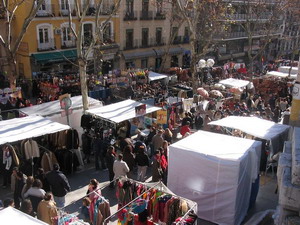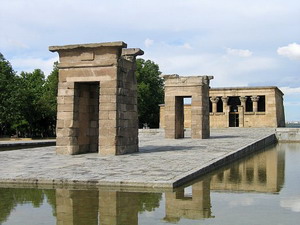Buy
at AllPosters.com


El
Rastro Flea Market - Temple of Debod
- Royal Theatre
El
Rastro Flea Market Madrid Travel Information
El Rastro de Madrid or
simply el Rastro is the most popular open air flea market in Madrid (Spain).
It is held every Sunday and public holiday during the year and is located
along Plaza de Cascorro and Ribera de Curtidores, between Calle Embajadores
and the Ronda de Toledo (just south of La Latina metro station).
A great variety of products
(new and used) can be found at el Rastro. A number of antique shops in
the local area are also open on Sunday.
El Rastro means "the trail".
The market probably owes its name to the tanneries that were once located
in Ribera de Curtidores (Ribera de Curtidores means 'riverside of tanners').
Close by, on the banks of the Manzanares River, was an abattoir. Transporting
the slaughtered cattle from the abattoir to the tannery left a trail (rastro)
of blood along the street. An alternative etymology suggests el Rastro
once meant “outside”, referring to the fact el Rastro was once outside
the jurisdiction of the mayor’s court
 Location
and times Location
and times
According to municipal rules,
el Rastro takes place every Sunday and public holiday of the year, from
9 am to 3 pm, in the barrio de Embajadores ('Ambassador’s district') in
the Central District of Madrid. The Madrid town council regulates the markets.
A maximum of 3500 stalls cover the area from the Plaza de Cascorro, with
its statue dedicated to Eloy Gonzalo, who was a Spanish soldier who fought
in the Cuban War of Independence in which he distinguished himself and
is regarded as a hero, in the north, along the main thoroughfare of Ribera
de Curtidores and adjoining streets to Calle Embajadores in the east and
the Ronda de Toledo and Plaza del Campillo del Mundo Nuevo in the south.
Transport
El Rastro can be accessed
from the following Madrid Metro stations:
-
Line 3 from the stations Embajadores,
Lavapiés or Sol.
-
Line 5 from the stations La
Latina, Puerta de Toledo or Acacias.
-
Line 1 from the stations Tirso
de Molina or Sol.
-
Line 2 from the stations Sol
or Opera.
On market days, there are EMT
(Empresa Municipal de Transportes de Madrid) buses that stop close by.
It is also accessible from the commuter train network (Cercanías
Renfe) from the following stop: Línea C5 Embajadores
Specialty items
Certain streets or areas
within El Rastro are associated, either by tradition or by the gathering
of specialist stalls, with particular wares.
-
Calle Fray Ceferino Gonzales
is known as “calle de los Pajáros” ('street of the parrots') as
it was where peddlars and travelling sellers would sell domestic animals
and birds and associated paraphernalia.
-
Calle San Cayetano is also known
as "calle de los Pintores" ('street of the Painters'), as its permanent
stalls sell paintings and drawings and art supplies.
-
Stalls around calle Rodas and
the Plaza de General Vara del Rey (formerly Plaza de Antonio Zozaya) and
Plaza de Campillo del Mundo Nuevo specialise in buying and selling magazines,
trading cards and stamps. A frequent sight in this area is young children
swapping and trading with each other.
-
Calle Carnero and calle Carlos
Arniches are where bouquinistas sell old, rare and collectible books.
-
The Plaza de Cascorro specialises
in selling funky clothing and accessories.
-
Calle Mira el Sol is for the
movie buffs with everything from Andrei Tarkovsky to Pajares.
|
|
Top
|
Temple
of Debod Madrid Travel Information

| The Temple of Debod is an
ancient Egyptian temple which was rebuilt in Madrid, Spain.
The temple was built originally
15 km south of Aswan in southern Egypt very close to the first cataract
of the Nile and to the great religious center dedicated to the goddess
Isis, in Philae. In the early 2nd century BC, Adikhalamani (Tabriqo), the
Kushite king of Meroë, started its construction by building a small
single room chapel dedicated to the god Amun.
It was built and decorated
on a similar design to the later Meroitic chapel on which the Temple of
Dakka is based. Later, during the reigns of Ptolemy VI, Ptolemy VIII and
Ptolemy XII of the Ptolemaic dynasty, it was extended on all four sides
to form a small temple, 12 X 15 m, which was dedicated to Isis of Philae.
The Roman emperors Augustus and Tiberius completed its decorations.
From the quay, a long processional
way leads to the stone-built enclosure wall, through three stone pylon
gateways and finally to the temple itself. The pranaos, which had four
columns with composite capitals collapsed in 1868, and is now lost. Behind
it lay the original sanctuary of Amun, the offering table room and a later
sanctuary with several side-rooms and stairs to the roof. |

Templo
De Debod, Madrid, Spain
Buy
at AllPosters.com
|

 |
In 1960, due to the construction
of the Great Dam of Aswan and the consequent threat posed to several monuments
and archeological sites, UNESCO made an international call to save this
rich historical legacy.
As a sign of gratitude for
the help provided by Spain in saving the temples of Abu Simbel, the Egyptian
state donated the temple of Debod to Spain in 1968.
The temple was rebuilt in
one of Spain's most beautiful parks, the Parque de Rosales, near the royal
palace of Madrid, and opened to the public in 1972. It constitutes one
of the few works of ancient Egyptian architecture which can be seen outside
Egypt and the only one of its kind in Spain. |
 |
|
Top
|
Teatro Real Madrid Travel
Information
.jpg) The
Teatro
Real (literally Royal Theatre) or simply El Real (as it is known colloquially),
is a major opera house located in Madrid, Spain. The
Teatro
Real (literally Royal Theatre) or simply El Real (as it is known colloquially),
is a major opera house located in Madrid, Spain.
The company
The theatre stages around
seventeen opera titles (both own productions and co-productions with other
major European opera houses) per year, as well as two or three major ballets
and several recitals. The orchestra of the Teatro Real is the Orquesta
Sinfónica de Madrid. The present musical director is Jesús
López-Cobos. The general director will be Gérard Mortier,
effective January 2010. |
Top
|

